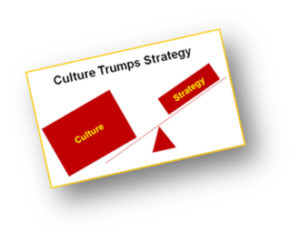By Ray Adler, CEO BTI Growth Advisors, Inc. This blog shines a light not just on the inefficiencies in your bank’s sales efforts but also why banks are having such difficulties evolving with the times. To better understand the difficulty banks are experiencing in their efforts to evolve and improve performance, we don’t need to […]
Tag Archive for: Bank Culture
What separates the top 10% of sales personnel from the bottom 90%?
They are diligent about how they spend their time.
In banking, and likely many other fields, there is always something to do to take care of your customer. When you place your focus on always serving, the marketing function doesn’t happen. And when you stop marketing, your pipeline flatlines! I don’t know about you, but I hate waking up a 3 a.m., staring at the ceiling, wondering where my next deal is coming from. Read more
All the big successful companies––like Apple, Google, Starbucks and others––know that the key to success is having stellar front-line staff who can actively and positively engage with clients. First impressions are important and could mean the difference between success and failure in your business. To attract these key individuals, you’ll need to consider your culture, collaboration, and communication.
Create an Attractive Culture
Good salaries are important, but first employees must want to jump out of bed in the morning, eager to begin their day at the office. This is where the culture of your organization must be considered.
“If you’ve created an environment where employees are heard, valued, and respected, you’ve got a clear competitive advantage to tout. Go beyond vetting candidates to selling them on a genuine culture you’ve established,” says Peggy Shell, founder and CEO of Creative Alignments. Employees want to know their work matters. They want to be challenged and learn with a great team of collaborators who are passionate. They want to work for someone who cares and gives back.”
Effective Collaborations
It’s also important that you think of in terms of the whole. Each employee should be aware of the offerings in other departments. At Apple, it’s common place for everyone to be on the sales floor selling before they move into other positions such as training and technical repairs. The company also provides opportunities for employees to do short assignments in other positions within the stores (such as leadership) or even transfer short-term to other stores, even those in foreign countries. This provides the employees with an overarching knowledge of the company’s functions and renewed enthusiasm for working for the company. They are less likely to stagnate and feel isolated by knowing they are part of a greater whole.
Empower Your Team
Training is key to empowering your team. In the banking world, training and in-house universities have fallen by the wayside. While your older employees may have benefited initially from additional training, younger employees are often wandering around in the dark and hitting plateaus that might send them searching for adventure elsewhere. Employees need to be supported in growing and expanding their contribution to the organization. Stagnation and inertia lead to low morale, disillusionment, and eventually high levels of turnover. Training new people often is more costly than providing avenues of learning for your current employees.
Communicate
Imperative above all else is communication. Leadership must be open to listening to the concerns and contributions of their entire team––especially those on the front lines. Customer relationships are formed here first. Very often those employees who interact with the customer initially may find solutions to customer service issues––or be able to enhance the relationship with that customer by providing solutions to their problems.
So if you and your leadership team wish to make even one small change that will ensure a brighter future for your organization, Stop, Look, and Listen.
- Stop thinking that you know it all and that the way it’s been done is the way it should be done forever.
- Look for opportunities to change the way your business is done.
- Listen to your team. They may know more than you give them credit for.
Then be prepared to take action on suggestions that while they might be a little innovative, they might just mean setting the stage for your organization to stand out among others.
To your success!
Ray
If bringing in quality new deposit and C&I customers is a priority in 2019, call me at (760) 720-9270. Let’s discuss your options and how to remain successful in a rising rate environment. Also click here to see my Sales Honing Academy website for more info.
Culture Gets “Lip Service” In Most Banks
Conceptually, most banking executives have a pretty good understanding of their bank’s culture. At least conceptually! Maybe you’d describe your bank’s culture as feeling very much like a “family” where employees care for each other and have each other’s backs. Often, I’ll have banking executives refer to their bank’s culture as a “community bank culture” and while these are both accurate descriptions, they’re also very limited descriptions of their bank’s culture.
Authors of Diagnosing and Changing Organizational Culture, Kim S. Cameron and Robert Quinn have this to say about what truly forms an organization’s culture: “The reason organizational culture was ignored as an important factor in accounting for organizational performance is that it refers to the taken-for-granted values, underlying assumptions, expectations, collective memories, and definitions present in an organization. It represents “how things are around here. It reflects the prevailing ideology that people carry inside their heads. It conveys a sense of identity to employees, provides unwritten, and often, unspoken guidelines for how to get along in the organization, and enhances the stability of the social system that they experience.”
The truth is, most of what actually forms a bank’s culture is taken-for-granted assumptions, unwritten and often unspoken guidelines for shaping employee behaviors. Wow! In such a highly-commoditized industry like banking, why would you ever allow one of the rare things that do differentiate one bank from another to be left in such a conceptual framework of understanding?
Starbucks Culture Is Very Clearly Defined
How is it that we can go into a Starbucks in any state — be it in a hotel lobby, airport or retail shopping center — and have the identical customer experience? How did they do that? Certainly, wasn’t luck! The reality is that Starbucks culture was designed and built over time to align with the founder’s vision for the brand. The culture is exactly the type of culture needed to attract and retain Starbucks loyal customers. It’s also the culture needed to differentiate Starbucks from its competitors.
Many executives don’t have the depth of understanding about what actually forms an organization’s culture. They also don’t realize there are four distinctly different types of cultures that exist in companies today:
The Clan Culture: This is a very family-like culture.
The Hierarchy Culture: This is a traditional corporate culture.
The Market Culture: This is a culture able to respond to changing market conditions.
The Adhocracy Culture: This is a culture that supports innovation.
Within each of these four types of cultures, there are a number of distinctly different behaviors. Every bank has employee behaviors that fall within each of these four different types of cultures.
Culture Trumps Strategy Every Time!
 The fact is any competitor in your market can easily and quickly replicate your product mix and marketing strategies. So that’s not going to give you a competitive advantage. Clearly, service levels do differ among banks however the fact that three out of four bankers refer to themselves as “a relationship bank” only serves to further commoditize the industry.
The fact is any competitor in your market can easily and quickly replicate your product mix and marketing strategies. So that’s not going to give you a competitive advantage. Clearly, service levels do differ among banks however the fact that three out of four bankers refer to themselves as “a relationship bank” only serves to further commoditize the industry.
One of the few things your competitors can’t readily replicate is your culture! That alone makes it something worth serious attention. The following are a couple examples of how we’ve helped banks define their current and ideal cultures. Once these have been defined, a bank has a clear roadmap of how the organization needs to evolve. On-boarding, performance management, and incentive compensation structures can all be evolved to help a bank preserve the part of their culture that has gotten them to their current level of success while making the changes needed to better ensure the bank’s success in the future. The same holds true for banks acquiring or merging.

Well-known brands like Disney, Southwest Airlines, Harley Davidson, Ritz Carlton and Starbucks know exactly how important their cultures are to their positioning in the market and their ability to attract and retain loyal customers.
Isn’t it time banks start taking steps to define and align their cultures too?




